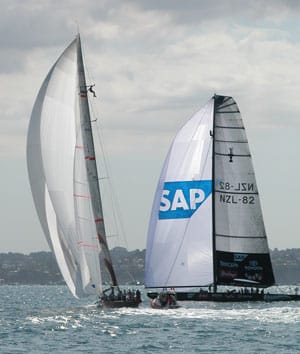
The greatest surprise of the America’s Cup unveiling Tuesday, other than Alinghi’s spirited can-can dancers, was that both finalists were essentially unchanged from January’s unveiling. Since Team New Zealand was not previously engaged in racing for survival, there was an air of expectation of a larger “hula” and shorter bulb for the Match, but TNZ’s only change appeared to be its hot-rod paint job on the bulb. The past month has been a time of refinement by both teams, rather than reconfiguration.
Alinghi (SUI-64) is an evolutionary derivative of NZL-60, the 2000 Americas Cup winner. However, Team New Zealand has continued to expand the Americas Cup Class design space with its controversial hull appendage, or “Hula,” and a radically long, slender bulb on NZL-82, the final build of this years Cup contenders.
Alinghis forward overhang has been steepened about 3 degrees since winning the Louis Vuitton Cup. According to the design team, this was to gain about 2 square meters of sail area (out of roughly 320 sq m of total rated sail area), while the offsetting increase in hydrodynamic drag is very small. Another small speed gain has been made by converting the cap shrouds (main side stays) from single round rod to double rods of smaller diameter, one behind the other, to achieve a more streamlined effect. (Rigging rods are required to be round by the class rule.) The aerodynamic drag reduction is claimed to be worth about a half-boatlength per beat. These are the visible refinements to the yacht, with similar attention to detail given to other aspects of performance and handling. Alinghi has seemed to be making every second count.
Compared to Alinghi, NZL-82 is a little beamier. The resulting added wetted surface of the hull, added surface of the longer bulb and viscous drag due caused by the Hulas edges and fuller shape produce a greater low-speed drag for NZL-82 than for SUI-64. However, the hula is expected to have an advantage at higher sailing speeds because of its increased sailing length. It appears that Team New Zealand has not gone completely in the high speed direction, though, backing off on rated length to buy more sail area in its rating. This would tend to neutralize the added frictional/viscous drag inherent in its hull design, perhaps even coming out ahead when sailing downwind.
The two yachts have only small differences in their sail plans. By class rule, the height of the mainsail and jibstay are at a fixed maximum. Alinghis and Team New Zealands fore triangles are nearly identical in dimensions. Both yachts have extensive upper roach in their mainsails. However, Alinghis is a little greater aloft, while Team New Zealands longer boom and somewhat more rounded mainsail leech appear to carry roughly 5 sq m more sail area (about 1.5 percent of total rated sail area) than Alinghis.
|
|
| |
|

|
| |
| Stuart Streuli|
| |
|
|
| |
| The Hula supposedly allows TNZ to carry an extra 120 square feet of sail area off the wind. But while Dean Barker and company were fast off the wind in Leg 2 of Race 2, they lost time in Legs 4 and 6.* * *|
| |
|
|
|
It might be expected that NZL-82s wider beam and lower-center-of-gravity bulb would show equal or greater sail-carrying ability compared to Alinghi, allowing for NZL-82s increased sail area, as well. However, it wasnt seen in the yachts abbreviated encounter in Race 1. NZL-82 looked quick off the starting line, but was heeling more than Alinghi. Perhaps she was already encumbered by substantial sea water aboard. Her bow was pointing higher than Alinghis, but she was losing gauge. However, NZL-82s relative performance against Alinghi in less pressed conditions remains speculative. Meanwhile, the potential of the Hula in fresh conditions remains talk rather than action.
The next days sailing, in Race 2, tested the other end of the wind spectrum. In perhaps the closest and best-sailed Americas Cup race ever, the speed potential of Alinghi and Team New Zealand appeared extremely close in 8- to 9-knot winds. Position on the course had more to do with gaining an advantage than did design differences. Alinghi eked out a small lead to windward on leg 1, only to lose it, and then some, on the first run. The impression that NZL-82 might have had an inherent speed edge downwind was dashed later when Alinghi made gains on each of the next two runs, including an impressive, come-from-behind overpowering of NZL-82 in the final minutes of the race. In light airs downwind, it is apparent that spinnaker selection creates bigger differences between the yachts than do the respective hulls and appendages.
During a down-speed tacking duel in the final beat, New Zealands small keel showed that it had enough area for the yacht to accelerate out of tacks and stretch its lead. There was no Achilles heel to be found there.
After two days, there is still a lot of racing ahead of Team New Zealand and Alinghi in their first-to-five series. The extraordinary problems that plagued TNZ in Race 1 are not likely to be repeated, both yachts have shown the potential to win in light airs, and their relative performance in mid-range conditions is still untested. Despite different design trade-offs made in these two yachts, the next week of racing may boil down to the most significant test of sailors ever to compete for the Americas Cup.









